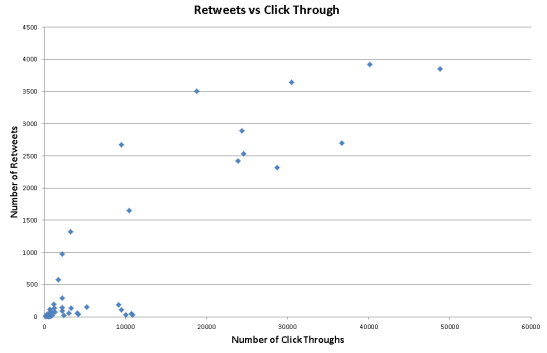Twitter is a terrible place to advertise your content
When people want to make a quick assessment of somebody’s digital presence they seem to be inevitably drawn to looking at the number of Twitter followers they have. The more a person has the more influence they must command, right?
I had a look at how many people click on the links tweeted by some big name Twitter users and found that, actually, very very few of their followers do.*
 Number of followers ≠ Influence
Number of followers ≠ Influence
A couple of days ago Katy Perry overtook Justin Bieber as the most followed person on Twitter, prompting The Salt Lake Tribune to declare her ruler of the internet. At the time of writing Perry had over 4.6 million followers. The average number of clicks on links she posted in her tweets, however, was only slightly more than 27,000. That means that only 0.058% of her followers are actually taking the trouble to click on her links – about 1 in every 1700 followers. Not very impressive, especially from a marketing perspective.
Now, you might well argue that it is unreasonable to expect every single one of a person’s followers to read one of their tweets. Aren’t they here one second and gone the next? Actually, the average time it takes for a tweet to lose relevance is far longer than you’d expect, somewhere around the 2.8 hours mark. Ample time for a good number of your followers to see your tweet. This makes it more surprising that so few people actually engage with the people who they follow.
Last week The Telegraph named Stephen Fry as the 11th most influential Tweeter in Britain. With 6.3 million followers you might well be inclined to agree, but only about 5000 of those people click on the links that Fry posts. That’s 0.08% of his following; bad news for all the charitable causes he regularly plugs.
It seems clear that the size of the audience you engage is negligible compared to your Twitter following and this is a problem for those basing their promotional schemes on the number of people they can ‘theoretically’ reach on Twitter. NME, for instance, have just over 600, 000 followers. You might expect an NME follower to be interested in NME’s content and be part of a digitally savvy age group, but only an average of 0.2% click through to articles posted by NME.
So how should you promote your content?
It is clear, then, that relying on hits to your web page via Twitter is foolish. You are extremely unlikely to attract enough people to keep yourself solvent.
And it doesn’t matter how big or small you are. The Hackney Gazette has 10,769 followers, much lower than NME. You might think that because they serve a specifically defined community the Hackney Gazette would get a higher percentage of their followers clicking through, but at 0.023% they have an even lower click-through rate.
One factor which does seem to proportionally improve your click-through stats is the number of retweets you receive.
The graph above shows this relationship fairly clearly. The more people who interact with your content the more views it will reliably get.
How you can get people to interact with you, however, is a difficult game. Articles like this one and pages like this one demonstrate the lengths that advertisers will go to to create some kind of relationship with the reader.
 I think that the best way grow a reader base is to start small and hook them in by talking to them and finding out what they want. Ensure that they keep coming back and word will grow that you provide a great service. The rise of social media, especially Twitter, has created the illusion that your potential audience is automatically the entire world. It is not. In order to interest people you still have to appeal to each one individually.
I think that the best way grow a reader base is to start small and hook them in by talking to them and finding out what they want. Ensure that they keep coming back and word will grow that you provide a great service. The rise of social media, especially Twitter, has created the illusion that your potential audience is automatically the entire world. It is not. In order to interest people you still have to appeal to each one individually.
There is no way of predicting what will go viral. You might get lucky. However, if you ignore the audience by posting links and hoping they get clicks, the likely outcome is that your audience will ignore you.
*I did this by trawling through their recent Tweets and selecting the Bitly links they had Tweeted. You can see how many clicks any Bitly link gets by pasting it into your browser and putting a + at the end of it. For each tweet I recorded how many clicks the link had got, how many people had re-tweeted or favourited it and the time it was posted. Although the people I mention posted lots of other non-Bitly links, I see no reason to think that the Bitly links are unrepresentative.



Do retweets get a higher CTR or is the increased number of clicks purely due to greater exposure? Great post, BTW
Thanks!
To be honest I don’t know. Unless the bit.ly link was subtly changed for every person who retweeted it I’m not sure there is a way of knowing using my method. I’d hope that people are retweeting due to having read it but I suppose you can’t bank on that.
Pingback: Journo stuff I’ve collected on 11/11/2013 at Sarah Hartley
Pingback: Newspapers on Twitter: who has the most click-throughs – and why? | Online Journalism Blog
Pingback: Charles Ayoub News Portal